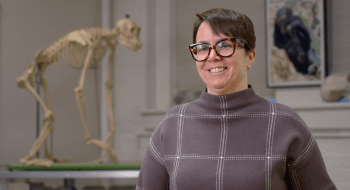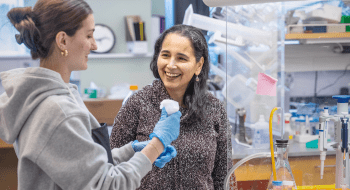
First Person: Building an Energy-Efficient Greenhouse on Campus
Pro tip: if you ever sign up for an Environmental Studies course titled “Practicum,” don’t wear you cool new “first-day-of-school” shoes to the very first session. I learned that lesson this semester when I registered for a class that revolves around helping to build an energy-efficient greenhouse at St. Lawrence’s Living Lab.
When it’s time to register for classes each semester, I usually have a few requirements for my Environmental Studies and Sociology combined major to take, but there is always a “wild card” class that I sign up for to fill my schedule. These classes always tend to be my favorites. This fall, “Practicum” was my “wild card.” I barely knew what it meant when I signed up, but I saw that it was taught by one of my favorite professors, Aaron Iverson, so I knew it had to be destined for greatness.
Come to find out, “Practicum” is like no other class I have taken at St. Lawrence, in a good way, of course! On day one, I found myself wearing a hard hat and mixing cement within a matter of minutes. My shoes and I survived the first session, but I was sure to leave them at home for the next class.
St. Lawrence’s Living Lab is a 110-acre tract of land about a mile from the main campus. It includes streams, wetlands, fields, forests, a small garden, and a three-story house. The goal of adding an energy-efficient greenhouse is to be able to grow citrus fruits year-round—even in the bitterly cold North Country winters.
"Undoubtedly, this class has been a valuable learning experience in an unconventional classroom space. I have had to step out of my comfort zone, put my cool new shoes back on the shelf, and put my hands and mind to work." —Rosie Gotsch '22
I won’t go into the nitty gritty of its build and design, but this in-ground greenhouse uses geothermal energy to heat and cool its interior all year long. Working together as a class, we have had to understand and apply the design principles of geothermal temperature control to prioritize energy efficiency and sustainability. Don’t forget, the stakes are high—there are fresh, local citrus fruits on the line here!
Even if it sounds like it, “Practicum” isn’t all just fun and games. In addition to constructing the greenhouse, this course incorporates independent research projects exploring local food systems. My classmates and I also engage in daily discussions surrounding the challenges, opportunities, and pathways towards developing resilient local food systems.
Undoubtedly, this class has been a valuable learning experience in an unconventional classroom space. I have had to step out of my comfort zone, put my cool new shoes back on the shelf, and put my hands and mind to work. Not only have I learned a lot about the planning and execution of a building project, but “Practicum” also offers a practical application of the many skills I’ll need in any job. I have learned the importance of teamwork and problem solving while working towards a common goal: constructing a functional year-round greenhouse that will supply local foods to the St. Lawrence community.
Even after four years here, St. Lawrence classes continue to surprise me. St. Lawrence has a special gift of engaging students in the most unconventional ways. The next time registration rolls around, the best advice I can give to any St. Lawrence student is embrace that “wild card” course. You never know where that class might take you, or where you might find yourself… maybe even in a hard hat.




